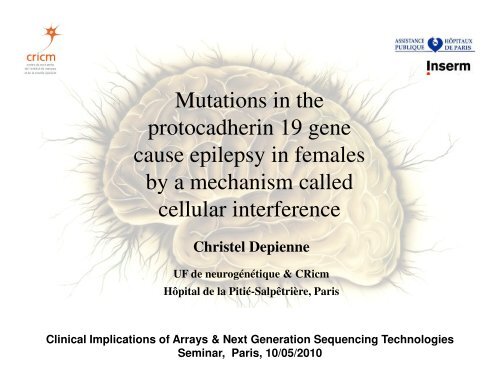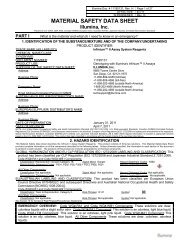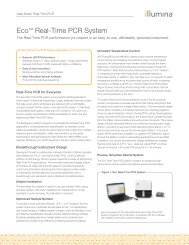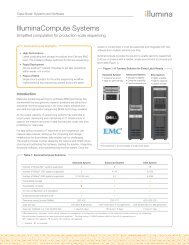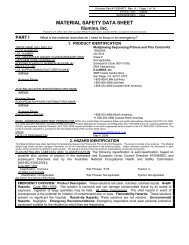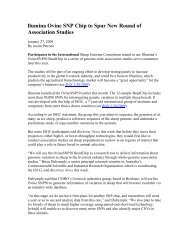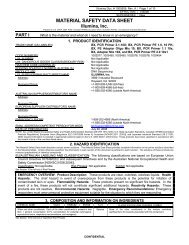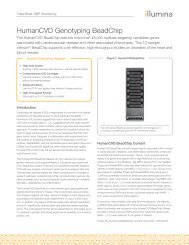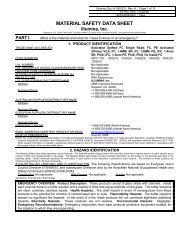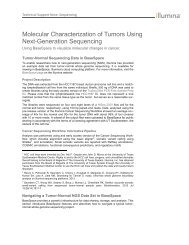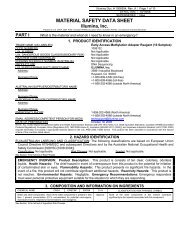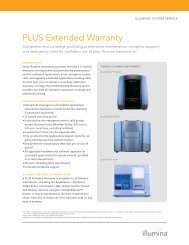Mutations in the protocadherin 19 gene cause epilepsy in ... - Illumina
Mutations in the protocadherin 19 gene cause epilepsy in ... - Illumina
Mutations in the protocadherin 19 gene cause epilepsy in ... - Illumina
You also want an ePaper? Increase the reach of your titles
YUMPU automatically turns print PDFs into web optimized ePapers that Google loves.
<strong>Mutations</strong> <strong>in</strong> <strong>the</strong><br />
protocadher<strong>in</strong> <strong>19</strong> <strong>gene</strong><br />
<strong>cause</strong> <strong>epilepsy</strong> <strong>in</strong> females<br />
by a mechanism called<br />
cellular <strong>in</strong>terference<br />
Christel Depienne<br />
UF de neurogénétique & CRicm<br />
Hôpital de la Pitié-Salpêtrière, Paris<br />
Cl<strong>in</strong>ical Implications of Arrays & Next Generation Sequenc<strong>in</strong>g Technologies<br />
Sem<strong>in</strong>ar, Paris, 10/05/2010
Severe myoclonic <strong>epilepsy</strong> of <strong>in</strong>fancy<br />
or Dravet syndrome<br />
Normal PMD & MRI before <strong>the</strong> onset of seizures<br />
Onset < 1 yr: seizures +++ triggered by fever<br />
Febrile and afebrile polymorphic seizures<br />
(<strong>gene</strong>ralized, partial seizures & absences)<br />
Pharmacoresistant<br />
Psychomotor delay, myoclonic jerks > 2 yrs<br />
Na +<br />
Mental retardation, behavioral disturbances<br />
Sporadic cases<br />
70-80% de novo mutations <strong>in</strong> <strong>the</strong> SCN1A <strong>gene</strong><br />
(voltage-gated sodium channel alpha 1 or Nav1.1)<br />
β1<br />
α1<br />
P<br />
P<br />
β2<br />
P
Search for new <strong>gene</strong>s responsible for Dravet<br />
syndrome<br />
> 121 SCN1A-negative<br />
patients<br />
Search for microrearrangements<br />
Illum<strong>in</strong>a 370K<br />
arrays
Identification of a male patient with a hemizygous<br />
Xq22.1 deletion<br />
Mo<strong>the</strong>r<br />
Patient 1<br />
98.7<br />
98.9<br />
99.1<br />
99.3 99.5<br />
pseudo<strong>gene</strong> pseudo<strong>gene</strong> pseudo<strong>gene</strong><br />
PCDH<strong>19</strong>
Function of protocadher<strong>in</strong>s <strong>in</strong> <strong>the</strong> CNS<br />
• Highly expressed <strong>in</strong> CNS<br />
• Cadher<strong>in</strong> superfamily (δ2 protocadher<strong>in</strong>)<br />
• Membrane prote<strong>in</strong> (6 extracellular EC<br />
doma<strong>in</strong>s, 2 <strong>in</strong>tracellular CM doma<strong>in</strong>s)<br />
• Ca+-dependent homophilic/<br />
heterophilic Interactions<br />
Gaitan et Bouchard, 2006<br />
• Potential role <strong>in</strong> neuronal survival &<br />
migration dur<strong>in</strong>g development<br />
Screen<strong>in</strong>g of PCDH<strong>19</strong> <strong>in</strong> 73 SCN1A-negative DS patients
Identification of 9 different po<strong>in</strong>t mutations <strong>in</strong><br />
11 unrelated female patients<br />
c.142G>T/<br />
p.Glu48X<br />
c.352G>T/<br />
p.Glu118X<br />
c.859G>T/<br />
p.Glu287X<br />
c.506del/<br />
p.Thr169SerfsX43<br />
c.1036_1040dup/<br />
p.Asn347LysfsX23<br />
A<br />
R<br />
E/X<br />
T<br />
K<br />
V<br />
E/X<br />
I<br />
T<br />
R<br />
E/X<br />
L<br />
L<br />
T/S<br />
P/P<br />
N/T<br />
I<br />
N/K<br />
L/S<br />
L/T<br />
Proband<br />
Control<br />
c.361G>A/<br />
p.Asp121Asn<br />
I K D/N L<br />
c.595 G>C/<br />
p.Glu<strong>19</strong>9Gln<br />
D R E/Q T<br />
c.10<strong>19</strong>A>G/<br />
p.Asn340Ser<br />
D T N/S D<br />
c.1628T>C/<br />
p.Leu543Pro<br />
P S L/P Q<br />
Proband<br />
Control
Pedigrees & segregation of <strong>the</strong> mutations <strong>in</strong> <strong>the</strong><br />
families<br />
Family 1<br />
Family 2<br />
Family 3<br />
Family 4<br />
Family 5<br />
Family 6<br />
del = whole <strong>gene</strong><br />
deletion<br />
m = p.Glu48X<br />
m = p.Glu118X<br />
m = p.Glu287X<br />
m = p.Glu287X<br />
v = p.Arg1107Gly<br />
m = c.1036_1040dup5<br />
+ +/+ m +/+ + +/+<br />
+/+ del m/+ m/+ +/+ +/+ m/+<br />
2<br />
+/+<br />
m<br />
m/+<br />
+<br />
v<br />
+/+<br />
+/+<br />
m/+<br />
v/+<br />
m<br />
+/+ m m +/+<br />
m/+<br />
m/+<br />
Family 7<br />
Family 8<br />
Family 9<br />
Family 10<br />
Family 11<br />
Family 12<br />
m = c.506delC<br />
m = p.Asp121Asn<br />
m = p.Glu<strong>19</strong>9Gln<br />
m = p.Asn340Ser<br />
m = p.Asn340Ser<br />
m = p.Leu543Pro<br />
+ +/+<br />
m +/+<br />
+ +/+ + +/+ + +/+<br />
m +/+<br />
m/+<br />
m/+<br />
m/+<br />
m/+<br />
m/+<br />
m/+
An unusual X-l<strong>in</strong>ked <strong>in</strong>heritance<br />
Recessive X-l<strong>in</strong>ked<br />
X-l<strong>in</strong>ked with male spar<strong>in</strong>g<br />
.<br />
. .<br />
.<br />
.<br />
.<br />
PCDH<strong>19</strong><br />
Affected<br />
Unaffected<br />
Unaffected<br />
Affected
Pr<strong>in</strong>ciple of cellular <strong>in</strong>terference<br />
Normal <strong>in</strong>dividuals<br />
(male/ female)<br />
Mutated males<br />
(hemizygous)<br />
Mutated heterozygous<br />
females<br />
Random Mosaïc mutated X <strong>in</strong>activation males<br />
WT protocadher<strong>in</strong> <strong>19</strong><br />
is expressed <strong>in</strong> all<br />
neurons<br />
Mutated protocadher<strong>in</strong><br />
<strong>19</strong> is expressed <strong>in</strong> all<br />
neurons<br />
Co-existence of<br />
neurons express<strong>in</strong>g<br />
WT and mutated<br />
protocadher<strong>in</strong><br />
Asymptomatic<br />
Asymptomatic<br />
Epilepsy and MR
Mosaïcism <strong>in</strong> <strong>the</strong> patient with <strong>the</strong> PCDH<strong>19</strong> deletion<br />
Lymphocytes<br />
A<br />
100%<br />
Fibroblasts<br />
B 47% 53%<br />
Patient<br />
(male)<br />
C<br />
D<br />
Control<br />
(female)
Micro-rearrangements of PCDH<strong>19</strong> <strong>in</strong> females<br />
Deletion of exons 1-3<br />
Whole <strong>gene</strong> deletions<br />
N07 1329 (family 18)<br />
6.3 Mb<br />
+<br />
+/+<br />
+<br />
+/+<br />
del/+<br />
+/+ del/+<br />
del/+<br />
N07 0897 (family 17)<br />
0.5 Mb<br />
1,20<br />
1,00<br />
0,80<br />
0,60<br />
0,40<br />
Exon1<br />
Exon2<br />
Exon3<br />
Exon4<br />
Exon5<br />
Exon6<br />
N08 0125 (family 16)<br />
65 Kb<br />
0,20<br />
0,00<br />
N 08 0125 N 07 0897 N 07 1329 WT1 WT2<br />
TSPAN6<br />
PCDH11X<br />
NAP1L3<br />
DIAPH2<br />
PCDH<strong>19</strong><br />
SRPX2<br />
FAM133A<br />
TNMD<br />
SYTL4
<strong>Mutations</strong> of PCDH<strong>19</strong> <strong>in</strong> female patients with<br />
<strong>epilepsy</strong> but without cognitive impairment<br />
Generalized <strong>epilepsy</strong> with febrile seizures<br />
Cryptogenic partial <strong>epilepsy</strong><br />
m/+<br />
m +/+<br />
m/+<br />
m/+<br />
m/+<br />
m/+<br />
m/+<br />
m/+<br />
c.2656 C>T / p.Arg886X<br />
Exon 4<br />
c.437 C>G / p.Thr146Arg<br />
Exon 1<br />
V<br />
N S R/X A H<br />
S<br />
P G T/R R I<br />
Patient<br />
Control<br />
Patient<br />
Control
Conclusions<br />
• High-density SNP arrays are a good tool to identify microrearrangements<br />
and new <strong>gene</strong>s<br />
• PCDH<strong>19</strong>: new <strong>gene</strong> responsible for <strong>epilepsy</strong> +/- mental delay<br />
• Frequent mutations: 15% of female patients with <strong>epilepsy</strong> and FS<br />
• Unusual X-l<strong>in</strong>ked <strong>in</strong>heritance affect<strong>in</strong>g ma<strong>in</strong>ly females<br />
• Familial / sporadic cases (<strong>in</strong>herited / de novo)<br />
• New pathophysiological mechanism : cellular <strong>in</strong>terference
UF neurogénétique<br />
moléculaire et cellulaire<br />
Oriane Trouillard<br />
Eric Leguern<br />
Thanks to <strong>the</strong> families!<br />
U975<br />
Delph<strong>in</strong>e Bouteiller<br />
Alexis Brice<br />
Eric Leguern<br />
CRICM<br />
Cytogénétique<br />
Boris Keren<br />
Baya Benyahia<br />
P3S<br />
Wassila Carpentier<br />
Florent Soubrier<br />
Institut Coch<strong>in</strong><br />
Kar<strong>in</strong>e Poirier<br />
Jamel Chelly<br />
F<strong>in</strong>ancements: GIS Maladies rares, AP-HP, INSERM<br />
Cl<strong>in</strong>iciens<br />
Alexandra Afenjar, Paris<br />
Alexis Arzimanoglou, Lyon<br />
Nadia Bahi-Buisson, Paris<br />
Patrick Berqu<strong>in</strong>, Amiens<br />
Marie Bru, Nantes<br />
Claude Cances, Toulouse<br />
Denys Chaigne, Strasbourg<br />
Emmanuel Cheuret, Toulouse<br />
Anne Dusser, Kreml<strong>in</strong>-Bicêtre<br />
Agnès Gautier, Nantes<br />
Brigitte Gilbert-Dussardier, Poitiers<br />
Isabelle Gourf<strong>in</strong>kel-An, Paris<br />
Delph<strong>in</strong>e Héron, Paris<br />
Annie Lannuzel, Paris<br />
Gaetan Lesca, Lyon<br />
Hélène Maurey, Kreml<strong>in</strong>-Bicêtre<br />
Sophie Meyer, Bordeaux<br />
Rima Nabbout, Paris<br />
Isabelle Py, Cholet<br />
Serge Rivera, Bayonne<br />
François Rivier, Montpellier<br />
Aga<strong>the</strong> Roubertie, Montpellier<br />
Dom<strong>in</strong>ique Steschenko, Nancy<br />
Sandra Whalen, Paris<br />
Et les autres...
Craniofrontonasal syndrome<br />
• Ano<strong>the</strong>r disease with unusual X-l<strong>in</strong>ked <strong>in</strong>heritance<br />
Forward<br />
signal<strong>in</strong>g<br />
Wieland et al, 2004<br />
Twigg et al, 2004<br />
Eph R<br />
<strong>Mutations</strong> <strong>in</strong> Ephr<strong>in</strong> B1 (EFNB1 en Xq12)<br />
Ephr<strong>in</strong><br />
• Mouse model support<strong>in</strong>g cellular<br />
<strong>in</strong>terference as <strong>the</strong> pathological mechanism<br />
Compagni et al, 2003<br />
Reverse<br />
signal<strong>in</strong>g<br />
D’après Wieacker & Wieland, 2008


